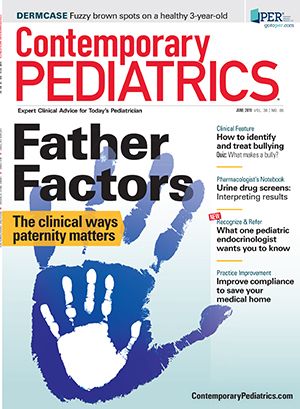Recognize & Refer: Turner syndrome
Contemporary Pediatrics sits down exclusively with Philippe F. Backeljauw, MD, a pediatric endocrinologist to discuss the one key condition for which he believes community pediatricians should be especially aware-Turner syndrome.
Philippe F. Backeljauw, MD

This month’s spotlight is on Endocrinology as Contemporary Pediatrics sits down exclusively with Philippe F. Backeljauw, MD, pediatric endocrinologist, director, Pediatric Endocrinology Fellowship Program, director, Cincinnati Center for Pediatric and Adult Turner Syndrome Care at Cincinnati Children’s Hospital Medical Center, clinical director, Cincinnati Center for Growth Disorders, and professor of Pediatrics, University of Cincinnati College of Medicine, Cincinnati, Ohio, to discuss the one key condition for which he believes community pediatricians should be especially aware-Turner syndrome.
Q. Dr. Backeljauw, can you tell us a little bit about Turner syndrome and why you think that’s something of particular concern for pediatricians?
A. Turner syndrome is a disorder that solely affects females, so girls and women can be diagnosed as having Turner syndrome. It is the most common sex chromosome disorder for females and it is caused by a complete or partial loss of 1 of the 2 sex chromosomes. In other words, Turner syndrome females will have 1 X-chromosome that’s normal and then they may miss the second X-chromosome, or they may miss part of the X-chromosome, or they may have an abnormal sex chromosome that could be an abnormal Y-chromosome. Because they lose a second sex chromosome, they can present with a number of clinical features, some of them known as sort of classic Turner syndrome features.
Nowadays, we like to view Turner syndrome from a broader perspective, and the few clinical features with which it may present may simply be short stature or delayed puberty or absence of menstrual periods-amenorrhea-and they may have little-to-no other phenotypic features. Patients may not have a lot of facial characteristics of Turner’s, and they may not have some of the classic comorbidities. That’s sort of what Turner syndrome is about.
Now, why it is important for primary care doctors to know about Turner syndrome is that they are most often the first-line physicians and providers to diagnose girls with Turner syndrome, and they should be aware of what the clinical presentation can be and what the absolute indications are to diagnose a girl with Turner syndrome. In the United States, if a girl with Turner syndrome is not diagnosed prenatally or is not diagnosed during infancy by the neonatal period or the first year of life, very often the diagnosis is not made until age 8 or 9 years. Girls with Turner syndrome sometimes get diagnosed as late as age 12 to 15 years, and many women end up being diagnosed during adulthood. In order to provide the best care, make the best recommendations for clinical management of all the potential comorbidities, it is essential that we make the diagnosis as early as possible, and therefore pediatricians are really the first to think about possible diagnosis and to make the appropriate referrals or do the appropriate initial testing.
So, when should pediatricians think about Turner syndrome? First and foremost, if one deals with a girl or adolescent who has unexplained short stature, one has to rule out Turner syndrome. If one deals with an adolescent girl who has delayed onset of puberty, who has primary amenorrhea, one needs to rule out Turner syndrome. In any newborn with the diagnosis of lymphedema or a significant left-sided heart defect like a bicuspid aortic valve, one has to think of Turner syndrome. Also, in any girl who has the typical phenotypic facial features of Turner syndrome, one also should consider that an absolute indication for genetic testing to rule out Turner syndrome. Some of the typical facial features of a girl with Turner syndrome will include bilateral ptosis of the eyelids, somewhat low-set but prominent external ears, maybe a small mandible that’s retrognathic, a high-arched palate, and a short and sometimes wide neck or a girl who presents with swelling of the hands and feet in the first years of life. These are absolute indications for testing for Turner syndrome and that testing is done by doing a karyotype, a cytogenetic analysis of the patient’s chromosome.
Q. Once pediatricians do decide they meet the kind of characteristics for a patient and they’ve thought about referring to a specialist, what are the best treatment options available, in your opinion? How do we treat patients with Turner syndrome?
A. That’s a good question. The primary subspecialist who manages Turner syndrome is a pediatric endocrinologist and that has to do with the many comorbidities related to the hormonal system-short stature and delayed puberty and, of course, infertility. When a pediatrician thinks that the child he or she examines could have Turner syndrome, he or she could always call the endocrinologist to discuss this, but one should feel free to do the karyotyping.
Once the diagnosis is confirmed, a number of screening tests need to be done because they’re so important for long-term morbidity and mortality. The screening tests include a referral to Cardiology to rule out underlying heart disease, which is most often left-sided congenital heart disease. A referral also needs to be done to Radiology for renal ultrasound because about a third of girls with Turner syndrome have kidney abnormalities. A referral also should be made to Pediatric Endocrinology. Usually the pediatric endocrinologist coordinates these other referrals that I just mentioned but the specific reasons to refer to Pediatric Endocrinology are to treat the short stature and to treat the delayed puberty.
The short stature can be treated adequately with growth hormone therapy, and the earlier the diagnosis is made, the earlier treatment can be started and the more likely it is that there will be a much-improved adult height outcome. The treatment of puberty consists of, first, an assessment of the patient’s potential to have some typical changes on her own. If that is not the case, puberty is induced by estrogen replacement therapy and progestin replacement therapy in a manner to duplicate what usually happens naturally.
Discussions need to be done regarding the potential for infertility, and oocyte retrieval is a possibility in some girls to preserve long-term fertility. Some girls with Turner syndrome do have spontaneous onset of puberty and may go through puberty on their own, although most of these girls will do so incompletely and may still need estrogen treatment. Very few girls have menstruation on their own and a very, very small amount of Turner syndrome women are able to cycle and conceive on their own. These are important issues to discuss with the family, and counseling is very important regarding these issues and should be done by people who have experience in the long-term care.
Aside from the treatment for short stature and growth failure and the treatment for estrogen or ovarian insufficiency, pediatric endocrinologists also very often coordinate the appropriate screening for comorbidities, not just for cardiovascular disease but also for hypertension, hyperlipidemia, hyperthyroidism, liver enzyme abnormalities, scoliosis, and so on. Also, there are now international guidelines as well as our clinical guidelines that provide up-to-date-as of 2017-recommendations of how to screen for all these potential comorbidities that may affect some of these girls. These comorbidities have variable prevalences but some of the most common ones are hypothyroidism and cardiovascular morbidity.
Q. Thank you so much. You gave us a lot of great information. Is there anything else you’d like to add just for community practitioners?
A. Yes. The crucial thing again, and I cannot underscore this enough, is the earlier diagnosis and that people need to think about the possibility of having Turner syndrome as an explanation for a girl who doesn’t grow normally, who falls off the growth curves. One doesn’t necessarily have to wait until the girl is below the third percentile. If there is a growth deceleration at any point in her childhood or adolescence that cannot be explained by another reason, one has to think of Turner syndrome. If a girl is late with puberty, one has to think of Turner syndrome. If a girl has had the beginning of puberty but does not have onset of menstruation and has primary amenorrhea or secondary amenorrhea, the provider needs to think of the possibility of Turner syndrome. The neonatologist needs to think of Turner syndrome with any neonate who has some of the typical features or some of the congenital heart disease.
It happens too often that people just don’t think about Turner syndrome and that’s the main message. Think about it and talk with colleagues, look up the typical features. The findings may be subtle, but people need to first think about Turner syndrome in order for them to be able to make the decision to order the test. That’s of crucial importance.

Newsletter
Access practical, evidence-based guidance to support better care for our youngest patients. Join our email list for the latest clinical updates.